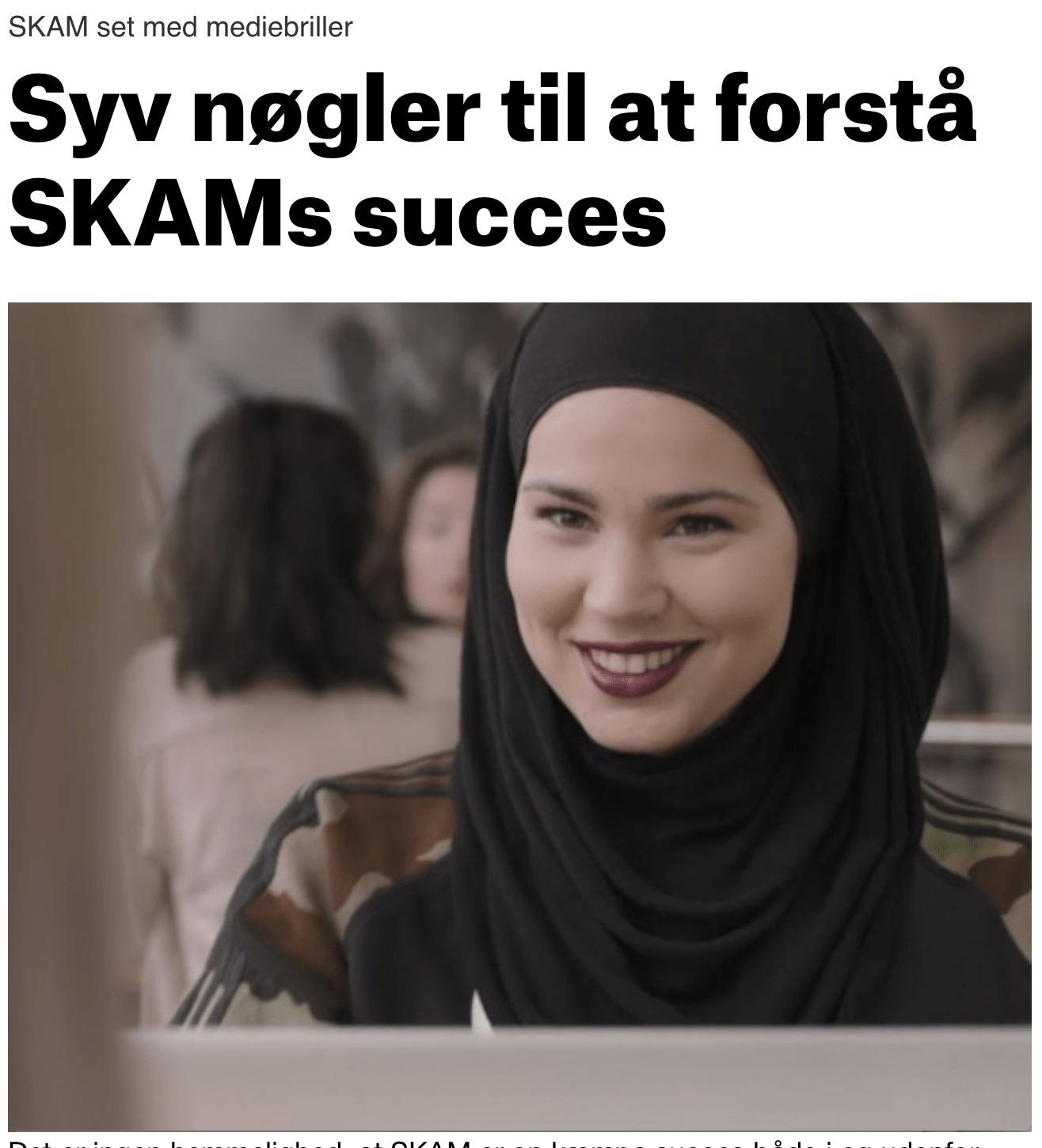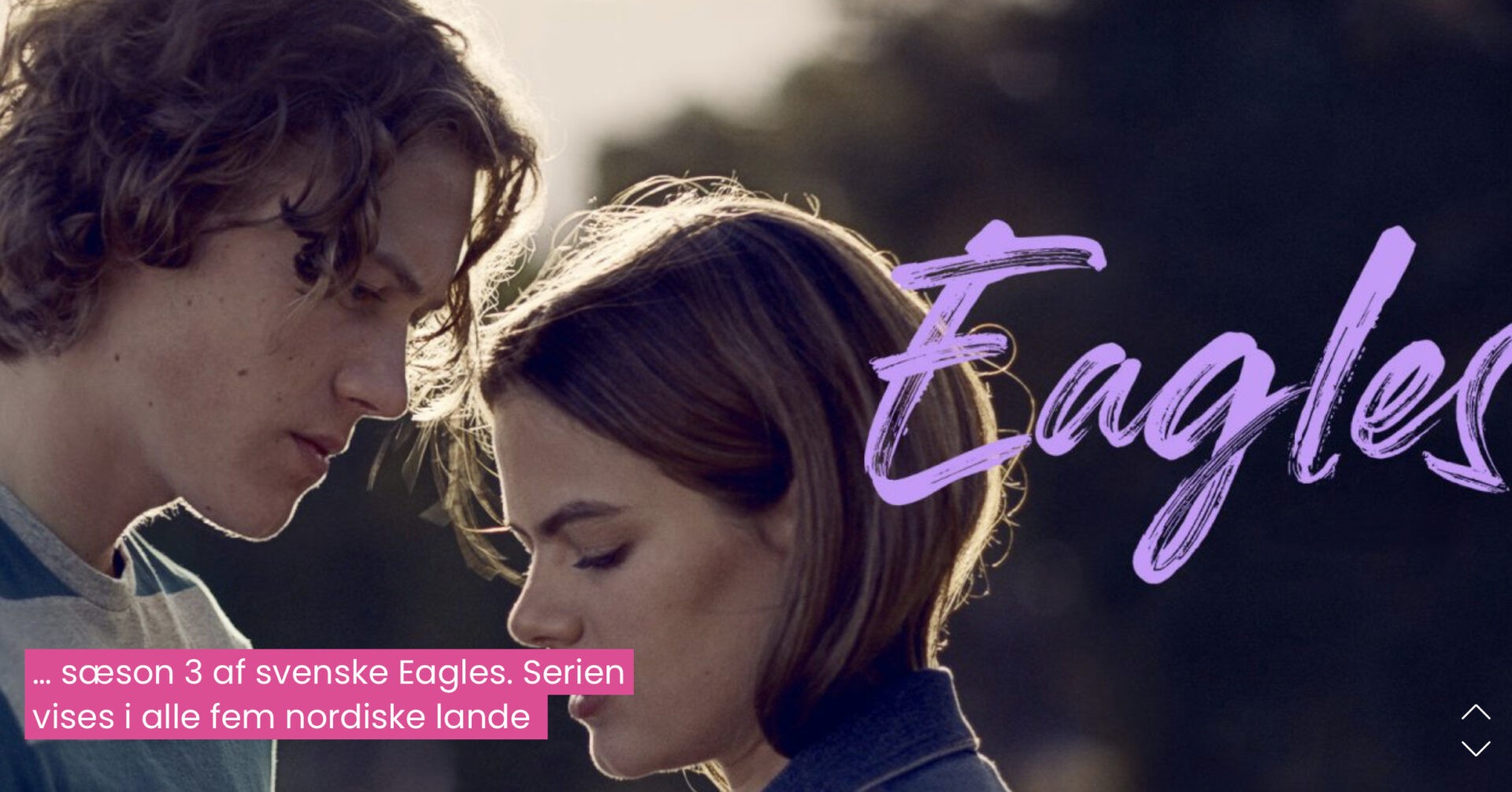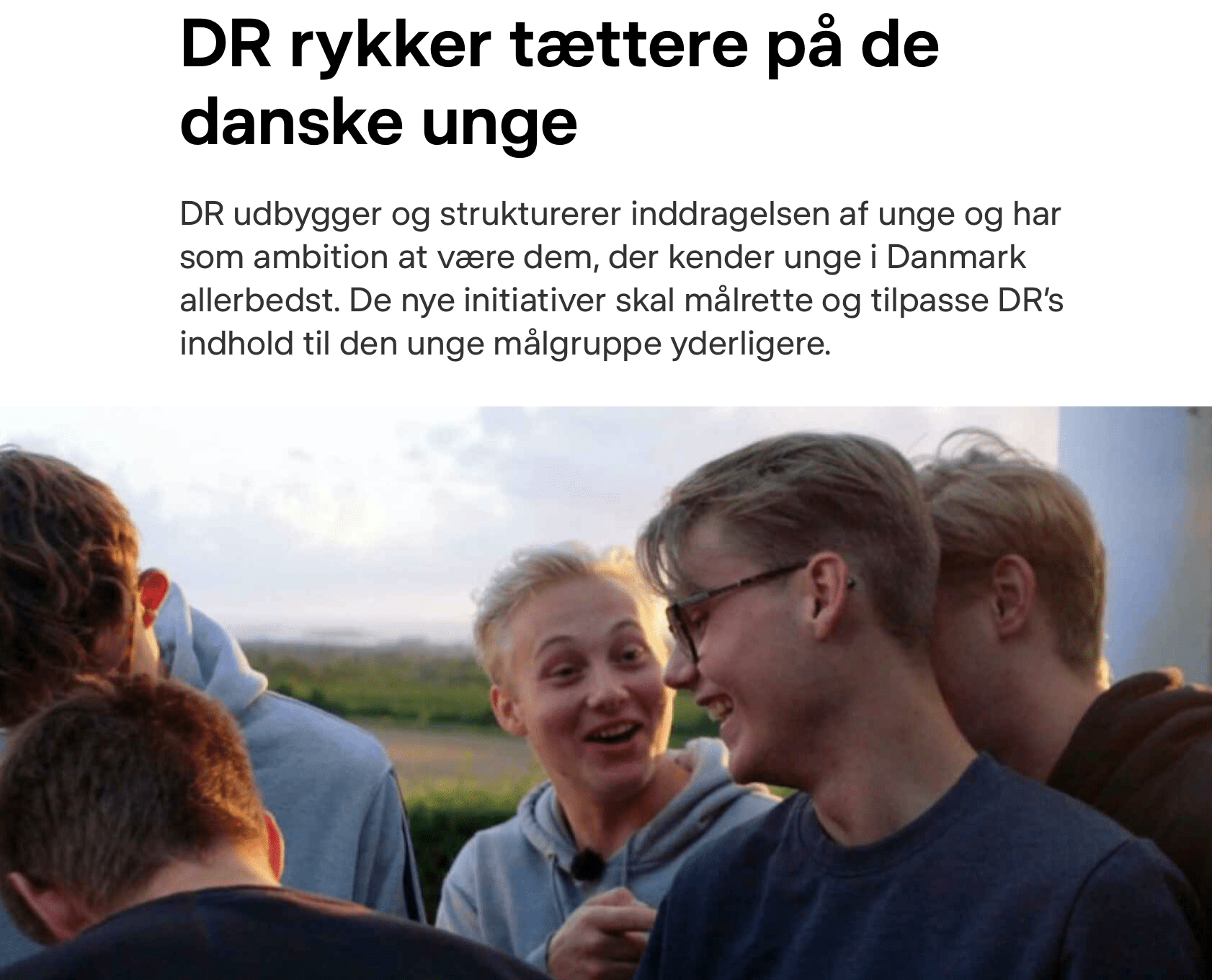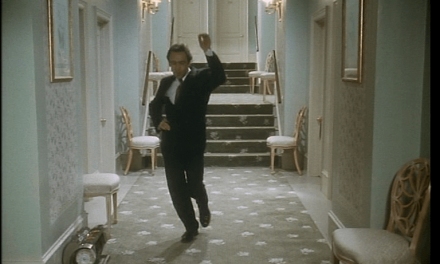In the mid-2010s, many Nordic public service broadcasters seemed to more or less give up on trying to reach the teenage audiences. These unfaithful viewers were hard to reach with the national productions while they consumed still more international content on global SVOD services, video-snacked on YouTube, chatted on social media and played digital games rather than look for the license-fee financed television fare.
In the Danish context, one contributing reason for this was that the teenage audiences were somewhat lost in the way the main public service broadcaster DR structured its niche channels in the 2010s. The DR Ultra channel for 7-12-year-old children (since 2020 for 9-14-year-olds) was launched in 2012, but there was no targeted content for teenagers. They were supposed to be interested in programmes from the DR3 channel launched in 2013 (online only from 2020) with the very wide intended audience of people between 15 and 39.

Fig. 1: DR3, targeting 15-39-year-olds, started focusing more on fictional content in 2018 with series such as Doggystyle. According to then Head of DR3 Irene Strøyer, the intention was to be ‘as close to the everyday life as possible’ (in Holm 2018). Screenshot from dr.dk.
Most teenagers didn’t see this as the most attractive offer around and naturally found other things to watch. In our household, this led to teenage binge-watching of sitcoms such as Friends (1994–2004) and How I Met Your Mother (2005–2014) – several times, I’m afraid – while one could sometimes convince the young generation to joint watching of ‘old’ quality US dramas such as The Wire (2002–2008). The affection for and interest in national content was basically nonexistent, and it’s hard to blame them considering what was produced, or rather not produced, targeting them.
SKAM as a well-researched game changer
The Norwegian teenage series SKAM (2015-2017) was in many ways a game changer in the Scandinavian television landscape. It seemed to come out of nowhere with a refreshing sense of how to appeal to young audiences by taking their everyday lives and concerns as well as their music taste and media use seriously based on extensive research among the intended main audience of 16-year-old girls (Redvall 2018).

Fig. 2: SKAM was in many ways a game changer in the Scandinavian television industry, and numerous industry events focused on the particular production framework behind the series and its publishing strategies. Screenshot from an article on ‘seven keys’ for understanding the series’ success from the Danish media website Kommunikationsforum.
As discussed in Vilde Schanke Sundet’s new book on television drama in the age of streaming and the strategies of the Norwegian public service broadcaster NRK, this series definitely didn’t come out of nowhere (2021). The series was the result of showrunner Julie Andem refining a certain way of storytelling and publishing content for many years, and the fact that the series didn’t only appeal to Norwegian teenagers but managed to cross borders and have an international viewership made several other Nordic broadcasters as well as production companies regain faith in trying to make fictional content for teenagers that can compete with the international fare. Following SKAM, a number of industry seminars tried to analyse the secrets behind the series’ success, and the SKAM makers and NRK representatives graciously shared their methods and findings in several talks and masterclasses (e.g. Redvall 2017).
New shared home grounds
Combined with the new possibilities for creating low-budget web series and SVOD services now making (expensive) original content in the Scandinavian languages (such as The Rain or Ragnarok), much has happened in the field of television drama targeting children, teenagers and adolescents in the past five years. Scandinavian children and teenagers now have much more national fiction to choose from and – encouraged by SKAM and successful public service remakes such as Klassen (The Class, 2016–, now made in national versions in both Denmark, Norway and Sweden) – there are several new initiatives to encourage more production – and more joint production – of content for children and young audiences.

Fig. 3: Danish viewers used to show little interest in watching Norwegian television drama. This is gradually changing, partly because of the new visibility and promotion of Norwegian series, such as Atlantic Crossing (2021), through the initiative Nordic12. Screenshot from dr.dk.
This development is partly inspired by new Nordic collaborations in television drama for adults. In 2018, the five Nordic public service broadcasters DR (Denmark), NRK (Norway), SVT (Sweden), Swedish Yle and RUV (Iceland) established the drama collaboration Nordic12 ensuring that 12 Nordic drama productions would be widely available on the players of all Nordic broadcasters and encouraging more Nordic co-production (Bauer 2018). This has led to a new visibility for Nordic fiction across the Nordic borders where more energy is now being spent promoting each other’s series. As an example, in May DR will relaunch the excellent Norwegian series Heimebane (Home Ground, 2018–, available internationally with PBS Masterpiece) for national audiences after the interest in other Norwegian series such as the historical drama Atlantic Crossing (2020), the youth series Rådebank (2020) and the dark financial drama Exit (2019–now) earlier this year.
Young adult drama as a new Nordic priority
In 2021, the Nordic12 collaboration was followed by the B14 (‘Childrens14’) framework which will give children in the Nordic region access to at least 14 new Nordic children’s fiction series each year (Jensen 2021a). DR, NRK and SVT will each participate with four series per year and YLE with one or two series made in various co-production set-ups. According to the Nordic public service media partnership organization Nordvision (which has existed since 1959), the past five years has seen a doubling in Nordic drama co-productions for children (Hartmann 2020), and the Nordic collaboration generally seems to be thriving. The 2020 annual report from Nordvision highlights collaborations on 77 Nordic drama and documentary series last year, and even more are in the pipeline for 2021 (Jensen 2021b).

Fig. 4b: … who liked SKAM in its annual report for 2020-2021.
Small nations teaming up seems like a wise strategy in the current media landscape and this is now also happening in the realm of youth dramas. In 2021, there will be 150.000 Euro from Nordvision for developing youth dramas (Hartmann 2021) and a new catalogue on the many joint Nordic productions from 2019-2020 illustrates how young adult drama is now a priority in the Nordvision collaboration (Nordvision 2020).
New research and youth panels
Several industry practitioners have recently highlighted how SKAM has been influential in facilitating this development. One of them is the producer of SVT’s popular youth series Eagles (2019–), Sanne Övermark, who argues that SKAM showed the other Nordic countries that one could in fact reach the young audience with quality public service content. Övermark finds that Norway still has the lead when it comes to youth dramas, but the other Nordic countries are trying to catch up (Övermark in Hartmann 2021). Currently Eagles (which can be seen with subtitles on dailymotion) is foregrounded by Nordvision as a series that might appeal to the teenagers – and many others – who liked SKAM. Its third season is launching in June 2021 and a fourth is in the making.

Fig. 5: In the strategy for DR moving towards 2025, DR wants to reach nine out of ten children and young people under the age of 25 on a weekly basis (DR 2019). Involving this target audience more through a ‘youth panel’ is one of the strategies for how to stay on their weekly media radar (Hansen 2021). Screenshot from dr.dk.
And last week DR presented a new qualitative report (conducted by the design anthropology consulting firm Will & Agency) into the ‘everyday lives, hopes, dreams, concerns and relations’ of 10–25-year-old Danes to try to gain a more nuanced understanding of this particular audience. DR encourages independent production companies to take this research into consideration when pitching new ideas for the desired ‘relatable content’, and the Danish public service broadcaster is also launching a new ‘youth panel’ with 300 young people who will provide continuous input and feedback (Olsen 2021). So more public service content for this audience is definitely in the making, and we look forward to following this in the RYA project.
Eva Novrup Redvall is Associate Professor at the University of Copenhagen where she is head of the Section for Film Studies and Creative Media Industries and principal investigator of the RYA research project. https://comm.ku.dk/staff/?pure=en%2Fpersons%2Feva-novrup-redvall(fc809983-e37f-4f44-b71a-a0b1d36295b9).html
References:
Bauer, Martin Bækker. 2018. ’Nordisk dramasamarbejde giver seerne adgang til nye dramaserier.’ Dr.dk., 19 April, 2018. https://dr.dk/om-dr/nyheder/nordisk-dramasamarbejde-giver-seerne-adgang-til-nye-dramaserier
DR. 2019.’DR vil bringe danskerne sammen om det vigtige.’ Dr.dk, 26 September, 2019. https://dr.dk/om-dr/organisationen/dr-vil-bringe-danskerne-sammen-om-det-vigtige
Hansen, Sarah Cecilie Simone. 2021. ’DR rykker tættere på de danske unge.’ Dr.dk, 20 April, 2021. https://dr.dk/om-dr/nyheder/dr-rykker-taettere-paa-de-danske-unge
Hartmann, Henrik. 2021. ’Efter SKAM kommer … Eagles.’ 10 February, 2021. https://2020.nordvision.org/#article-slider-74
Hartman, Henrik. 2020. ’Nordvision all set to launch major Nordic collaboration on children’s fiction.’ 30 November, 2020. https://nordvision.org/nyheter/nyhet/nordvision-all-set-to-launch-major-nordic-collaboration-on-childrens-fiction
Holm, Rikke Akselbo. 2018. DR3 klar med største fiktionssatsning til dato.’ Dr.dk, 26 October, 2018. https://dr.dk/om-dr/nyheder/dr3-klar-med-stoerste-fiktionssatsning-til-dato
Jensen, Ib Keld. 2021a. ’BØRN, Børnedrama sætter ekstra turbo på samarbejdet.’ 21 February, 2021. https://2020.nordvision.org/annual-report-article/boern-boernedrama-saetter-ekstra-turbo-paa-samarbejdet/
Jensen, Ib Keld. 2021b. Nordvision årsrapport: 2020 näst bästa året i tv-samarbetets historie. 1 March, 2021. https://nordvision.org/nyheter/nyhet/nordvisions-aarsrapport-2020-naest-baesta-aaret-i-tv-samarbetets-historia/
Nordvision. 2020. Young Adult Drama 2019-2020. https://nordvision.org/fileadmin/user_upload/NV_YA_catalog_20192020.pdf
Olsen, Emil Rømer. 2021. ’Nyt studie og ungdomspanel skal gøre DR skarpe på indhold til de unge.’ Mediawatch.dk, 20 April 2021. https://mediawatch.dk/Medienyt/TV/article12912664.ece
Redvall, Eva Novrup. 2017. ’Syv nøgler til at forstå SKAMs succes: SKAM set med mediebriller. Kommunikationsforum, 5 May, 2017. https://kommunikationsforum.dk/artikler/SKAM-norsk-serie-NRK-SKAM-set-med-mediebriller-syv-noegler-til-at-forstaa-succesen-bag
Redvall, Eva Novrup. 2018. ’Reaching Young Audiences Through Research: Using the NABC Method to Create the Norwegian Web Teenage Drama SKAM.’ In D. Thornley (ed.): True Event Adaptation: Scripting Real Lives. Basingstoke: Palgrave Macmillan, pp. 143–161.
Sundet, Vilde Schanke. 2021. Television Drama in the Age of Streaming: Transnational Strategies and Digital Production Cultures at the NRK. Cham: Palgrave Macmillan/Springer.






